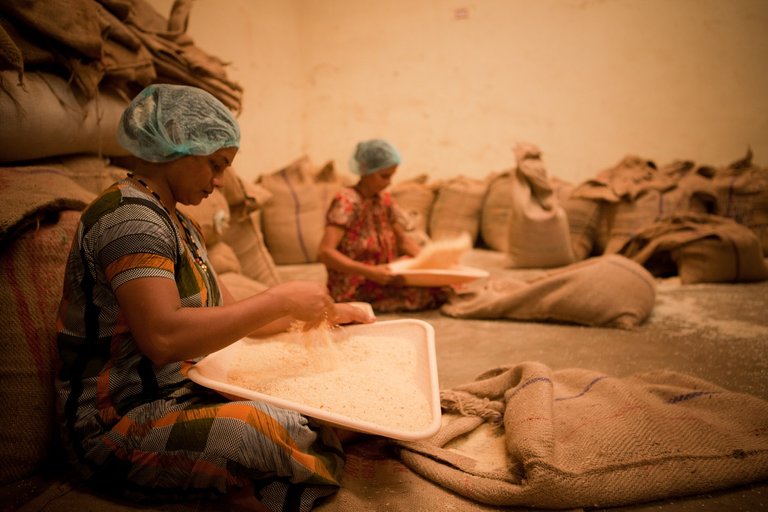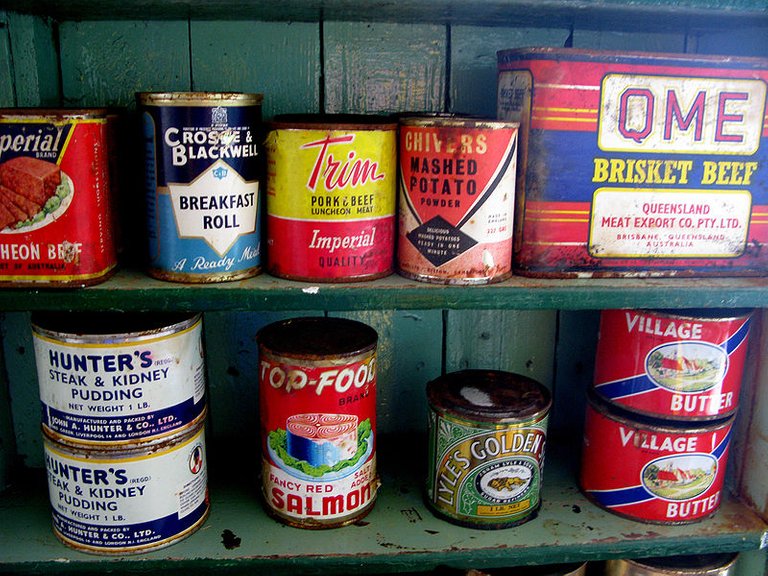Introduction
The science of processing food has developed as a result of the complex nature of food conbined with the ever increasing distance between where food is produced and where it may be consumed. The ancient methods used in processing and preserving of food which such as salting, drying smoking are still in vogue but what we will be discussing today is the modern day use of food processing and preservation. There is need for research to be made on how to process and preserve our food due to so many factors like food poisoning, food contamination which may be detrimental to our health. There are varieties of factors which contributes to food poisoning and contamination and therefore there are various means of preventing the main types of food poisoning. But before that, lets talk about the basic methods of processing food.

[image source: pixabay CCO licensed]
Food processing
Food processing is the various methods implemented in achieving and changing our agricultural products so as to make them edible for immediate consumption and preserved for future consumption. In other words, food processing is divided into two parts (i) food preparation (ii) food preservation. Food is been processed for many reasons such as aiding easy digestion since many of the nutrients are not readily available until been heated, increases the flavour of the food, making it soft to be chewed easily, making it safer for our health by killing the micro organism present in them and preserving it to avoid spoilage and contamination.
Methods involved in food preparation and processing
Separation and subdivision
This is the first step involved in preparation of food, this is very important so as to make food appealing and desirable to eat. Separation is the act of removing the parts of our agricultural products that are not needed and are harmful when consumed e.g removal of corn husk, pilling of potato. On the other hand, subdivision is removal of parts within the edible portion that will cause deterioration through spoilage. The methods involved in separation and subdivision of food includes cutting, pounding, grinding, peeling, paring, grating etc.
Combination and Mixing
Food is been combined and mixed together so as to achieve a desired taste and palatability. The processes involved are blending, beating, creaming, stirring, pressing etc. All this are done in order to increase and circulate the flavour of the food.
Heating
This is the most important of all the processes involved in food preparation. All substances in the universe contains heat but in various degrees. In order to change the structure or texture of a substance, we need to add or subtract heat from it. So heating of food is the process of increasing the heat present in our food in order words increasing the temperature of it so as to make them edible. When food are heated, it makes them soft which aids easy digestion and easy release of nutrients.
Cooling
This is the opposite of of heating. This is the process of removing the heat present in foods by cooling the environment that are placed. Refrigerators are the devices involved in cooling of food.
Chemicals
In modern day food processing and preservation, the use of chemicals is predominant. Chemicals are used to increase the flavour of foods and in long term preservation of food for example the use of salt (NaCl), monosodium glutamate is to improve the taste of our foods and the use of baking soda in the production of bread so as to make it rise. In recent times, many of these chemical processes are been questioned since it increases health risk.
Micro Organisms
The use of micro organism in food processing has been so important most especially to the food industries. These micro organisms serves various functions ranging from fermentation, to rising etc. It is important that the right amount, temperature and condition are provided because as useful as micro organism are, they are also the cause of food spoilage which causes food poisoning.
Food spoilage
In order for we to achieve a healthy and nourished body, we have to be cautious of what we eat and the processes involved in preparing what we eat. Food spoilage is an undesirable change caused by various factors which makes foods complete unsafe to eat. This changes can be detected by the smell, taste, sight or texture of the food. Food spoilage is caused by internal and external factors.
Internal factors
Enzymes are the main internal cause of food spoilage. Enzymes are naturally occurring in foods and they serve great importance such as breaking down of complex plant and animal biomolecules and in ripening of fruits. But the continuous activities of these enzymes causes rot and spoilage making the food inedible.
External environment factors
There are various external factors that are involve in food spoilage and they are
Temperature : Temperature changes in the storage of foods is very essential to be taken note of. This is because, change in temperature promotes and support the growth of food spoilage agents and it also causes direct damage to our food e.g our vegetables and fruits tissue breaks down after freezing making them venerable to attack by micro organisms.
Living things: The activities of living things such as bacteria, moulds, yeast, insects and rodents plays a crucial role in food spoilage. Some moulds and bacterias produces toxic substances in our food which are not noticeable in the eating quality and this are very dangerous to our health. While insects and rodents contaminates food with their hair and faeces which are dangerous to how health as they may lead to various diseases and infections.
Moisture: the addition or the the removal of water from the original water content of food also leads to food spoilage for example, the removal of water from bread will make it very hard and on the addition of water to it, it creates a supporting environment where micro organism can harbour which in turn leads to spoilage.
Oxygen - The presence of oxygen encourages spoilage in some food substance such as our vegetable oils. Rancidity which leads to distasteful smell and taste is is caused by oxygen in an uncomplete or complete oxidation reaction when fat and oil are exposed to air.
Light: when some foods such as fruits and oils are exposed to light, they deteriorate and get spoilt quickly. Lights causes changes in taste and colour of fats when exposed for a long time.
When an individual consumes food which is spoilt or has been contaminated will lead to various complications which are discussed below
Food Poisoning

[image Source: wikimedia commons Author: CDC. CC BY-SA 3.0 licensed]
The various factors which contributes to food spoilage which are discussed above sometimes leads to illnesses known as food poisoning. Food poisoning is caused by eating contaminated food by pathogenic microorganisms, parasites and their eggs, toxic chemicals and toxins. Symptoms of food poisoning ranges from mild stomach problems to serious clinical conditions.
Food Intoxication
This is another type of food borne illness as a result of toxins present in foods. These toxins maybe be present in food due to accidental contamination by farmers or may be present due to bacterias releasing toxins in food e.g clostridium perfringens is a bacteria that when consume in large amounts, produces toxins and spores which causes illness. Another well-known bacteria which causes food intoxication is the escherichia coli, which causes haemolytic uremic syndrome a kidney disease. It can get into the body by eating uncooked contaminated beef.
Food infection
Food infection is the process by which pathogenic orgaisms gets into the body of an individual through the food they eat. This organism causes various kinds of diseases and illnesses. For example, Salmonella which is the most common cause of food infection when ingested causes vomiting, abdominal pain, diarrhea, muscle weakness and nausea. These bacteria can only cause illness when consumed in large amount and when contaminated food are consumed raw or uncooked. Another cause of food infection is consuming of parasites or their eggs for example, pork meat contains a parasite called trichinella spiralis that is present in the muscle of pigs. When a contaminated pork is eaten uncooked or not cooked up 77°C which is the maximum temperature this bacteria can survive in, this parasites then grows in the intestine causing various illnesses.
Preservation and prevention of food spoilage
.jpg)
[image Source: wikimedia commons Author: Butterfly voyages - Serge Ouachée. CC BY-SA 3.0 licensed]
One of the factors contributing to food spoilage is negligence. Micro organism which causes food borne illnesses are everywhere, but if we can prepare our food in a sanitized environment and store our food safely most of these food borne illnesses can be avoided. Lets take a look at the various ways by which we can prevent food borne illnesses
Food handling
Good food handling is very vital in in order to help prevent food borne illnesses. Foods that are cooked should be kept at temperature higher than 66°C until it is been served and foods that are not ready to be eaten should be well preserved in the refrigerator at 3°C and below. Although, placing your food in the refrigerator doesn't kill these bacterias but it will reduce the activities of these bacterias and prevent them from multiplying. The washing of hands and keeping clean the environment where food is been prepared is also very essential.
Controlling light
Since high light affects food that contains high fat and vegetables, it is advisable to keep these types of food off the reach of light.
Drying or dehydration as means of preservation
The act of dehydrating or removing water from foods makes the food unfavourable for micro organism to grow. Although, removing water from foods doesn't kill these bacterias so it is advisable to always boil these food before eaten. Dehydration changes the taste of foods since it concentrates the flavours but it helps preserve foods for a very long period.
use of chemicals for preservation
The use of chemicals to preserve food is more predominant in the food industries. The various chemicals used in the preservation of food includes salt, alcohol, vinegar, nitrate, antioxidants, smoke, nitrogen and organic fruits. Let's take the use of sugar for instance, we all know sugar is used to add sweetish flavour to our food, but it can be used in the preservation of food at a very high concentration. Industries that produces jam and jellies makes use of fruit juices and pulp and high concentration of sugar to prohibit bacteria growth.
use of micro organism
The process of fermentation is of great importance because it is been utilized for food preservation. In the process of fermentation, micro organism converts sugars into lactic acid without forming any other unwanted products thereby making the environment unfavourable for other micro organism since they depend on sugar for growth.
Controlling Oxygen
This method is what is been used in canning of food and beer by food industries. The process involves heat of foods to dry off air, replacing oxygen with other gases that don't support combustion and sealing the can in vacuum. These sealed food or beer can be kept for a very long time without getting spoilt.
Moisture control
Food that gets spoilt under high environmental humidity can be prevented from spoilage by appropriate packaging. In the industries, foods that get spoilt under these conditions are monitored using hygrometer and the air is also kept dry using drying agents such as sillica gels and alumina.
References for further reading
Poti J.M. et. al., (2015). Is the degree of food processing and convenience linked with the nutritional quality of foods purchased by US households? Am J Clin Nutr. 101(6). Retrieved Aug 30, 2018 from https://www.ncbi.nlm.nih.gov/pmc/articles/PMC4441809/
Congratulations your post has been featured on the Stach Post Review Article.
Thanks for using the Stach Tag.
Keep Being Creative!.
Courtesy-Stach Curation team
DISCLAIMER: dropahead Curation Team does not necessarily share opinions expressed in this article, but find author's effort and/or contribution deserves better reward and visibility.
(maximize your curation rewards!)
with SteemConnect
12.5SP, 25SP, 50SP, 100SP, 250SP, 500SP, 1000SPDonate STEEM POWER to @dropahead
Do the above and we'll have more STEEM POWER to give YOU bigger rewards next time!
Are you a curator? Join our team! v1
Releasing the power of dropahead's Rewards Pool (DRP)
Peace, Abundance, and Liberty Network (PALnet) Discord Channel. It's a completely public and open space to all members of the Steemit community who voluntarily choose to be there.Congratulations! This post has been upvoted from the communal account, @minnowsupport, by Donefezy from the Minnow Support Project. It's a witness project run by aggroed, ausbitbank, teamsteem, someguy123, neoxian, followbtcnews, and netuoso. The goal is to help Steemit grow by supporting Minnows. Please find us at the
If you would like to delegate to the Minnow Support Project you can do so by clicking on the following links: 50SP, 100SP, 250SP, 500SP, 1000SP, 5000SP.
Be sure to leave at least 50SP undelegated on your account.
@donefezy, another great post! I found in it a lot of usefull information for me. Thank you!
Posted using Partiko Android
Thank you so much @cryptospa for leaving a wonderful comment
Trichinosis can be nasty. Looks cool under the scope, but the patient is not having a great time.
Since we are using the example of pork, I'm gonna add cysticercosis via Taenia solium. That one can become extremely disturbing in ways they can show up in your body.
Good write up again.
I think this is why pork was "unclean" in Old Testament times. .
A lot of the "unclean" things of the Old Testament required extra, or more careful, processing in order to be consumed safely.
You are absolutely correct @enforcer48. Thanks for the wonderful contribution
Good article. It's also worth looking at how our ancestors preserved food. They had all sorts of clever ways of managing the glut of the summer or the slaughter to make it last.
Yea, that's true. But do you think we still need that even with modern day inventions?
It is absolutely essential that we do not lose the old skills! There are so many methods that do not require electricity or modern conveniences - it is important to remember these skills as there may come a time when electricity isn't so plentiful.
Wow, you are absolutely correct. Thanks for your wonderful comments and contribution
Congratulations! Your post has been selected as a daily Steemit truffle! It is listed on rank 9 of all contributions awarded today. You can find the TOP DAILY TRUFFLE PICKS HERE.
I upvoted your contribution because to my mind your post is at least 7 SBD worth and should receive 225 votes. It's now up to the lovely Steemit community to make this come true.
I am
TrufflePig, an Artificial Intelligence Bot that helps minnows and content curators using Machine Learning. If you are curious how I select content, you can find an explanation here!Have a nice day and sincerely yours,

TrufflePigyou can also support the girlsfoundation by following our curation trail using steemautoThanks for using the girlsfoundation tag as one of your tags. Don't forget to follow @girlsfoundation.
This post has been voted on by the steemstem curation team and voting trail.
There is more to SteemSTEM than just writing posts, check here for some more tips on being a community member. You can also join our discord here to get to know the rest of the community!
Congratulations @donefezyIssue 95, your post has been selected by the @asapers for a resteem and a feature in our brand new curation post.
What does this mean for you? Well first an upvote from some members of the team, we are no @curie or @ocd but who is going to be unhappy with some extra upvotes. Also each post featured in the article will receive a 10% share of the SBD generated from the curation post.
Please wait seven to ten days for payout. Keep up the great work and please consider supporting the @asapers with an upvote and/or a resteem on the post you feature in.
Your friendly @asapers
Giving back A.S.A.P
Lovely detailed read @donefezy Actually preservance need some chemical..and anytype of chemical is harmful for our health ....just my though
Posted using Partiko Android
Hi @donefezy!
Your post was upvoted by utopian.io in cooperation with steemstem - supporting knowledge, innovation and technological advancement on the Steem Blockchain.
Contribute to Open Source with utopian.io
Learn how to contribute on our website and join the new open source economy.
Want to chat? Join the Utopian Community on Discord https://discord.gg/h52nFrV
Monosodium glutamate has some nasty adverse reactions! Because of my Lyme and my diet each time I eat something that has MSG I get bad headaches, the tingling sensation increases and somedays I even get nausea from it. Problem is that MSG is used by most restaurants and food producers.
@donefezy,
Well written article. What I'd be really be fascinated by, though, is an article about ancient preservation techniques.
Quill
Very well done and researched article. Almost information overload. It is neat to see what processes used. keep up the great work.
I found you from @asapers featuring you.
Very informative!
The Daily Sneak.Thanks to @viking-ventures, this post was resteemed and highlighted in today's edition of
Thank you for your efforts to create quality content!